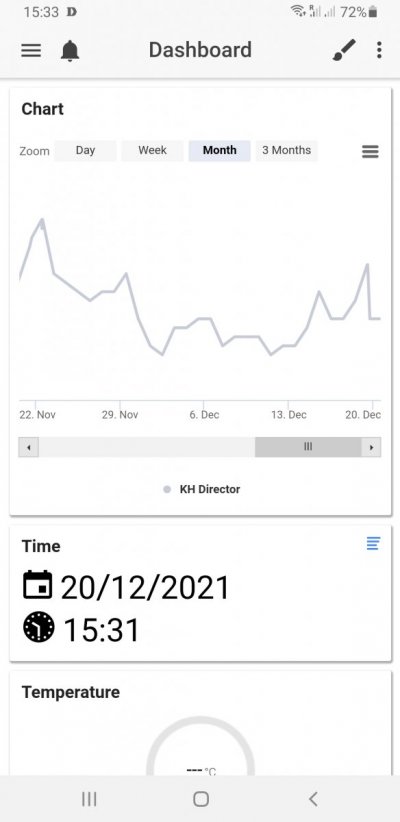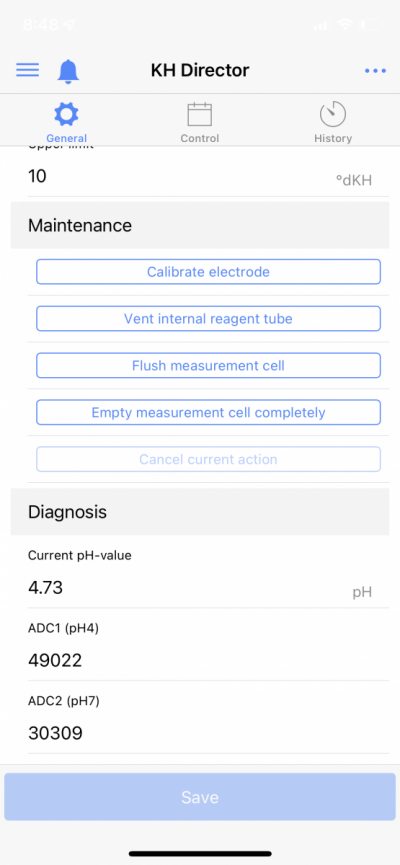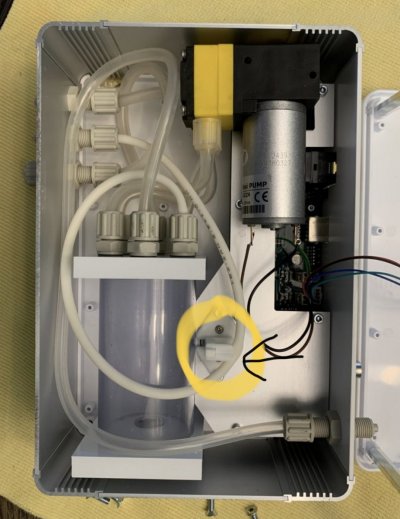Hi,
I own a KH director for around 6-7 weeks. The start was quite difficult till the GHL apps accepted me in the GHL connect, rejections for a couple of days days till suddently it worked.
After several days getting weird values the problem turned out to be that I got a lemon probe since the ADC calibration values were out of expected range. I got a new one from GHL Germany. Then for about 4 weeks I have been getting values with some error respect to the Hanna or Salifert values, around 0,3 KH units. Not really happy since Salifert and Hanna match quite close together, always the KH director looks the wrong one. In the last days the bias started to grow and reached around 1 KH unit.
Yesterday I recalibrated the pH sonde and it was quite the same ADC values as the las time. For the dosing pumps recalibration the one that is filling the probe changed from 32 in the previous calibration one month ago to 36 ml/minute. It looks a better value since the nominal of the pump is 40 ml/min. After correction I started to get values that are above 1 KH offset, see the table below.
Now I wonder if in addition to the lemon pH probe I also got a lemon dosing pump. I do not understand why I cannot open the unit and see how much it is being refilled, or why the prove is not visible, it would help in the debugging.
Below the comparison table of various days whe I took measurements with Hanna and/or Salifert and the display in the app showing very noisy values. I am very sorry to say that this product is quite disappointing for me.
It is a 2 months old lps tank with Tropic Marin all for reef one component dosing.

I own a KH director for around 6-7 weeks. The start was quite difficult till the GHL apps accepted me in the GHL connect, rejections for a couple of days days till suddently it worked.
After several days getting weird values the problem turned out to be that I got a lemon probe since the ADC calibration values were out of expected range. I got a new one from GHL Germany. Then for about 4 weeks I have been getting values with some error respect to the Hanna or Salifert values, around 0,3 KH units. Not really happy since Salifert and Hanna match quite close together, always the KH director looks the wrong one. In the last days the bias started to grow and reached around 1 KH unit.
Yesterday I recalibrated the pH sonde and it was quite the same ADC values as the las time. For the dosing pumps recalibration the one that is filling the probe changed from 32 in the previous calibration one month ago to 36 ml/minute. It looks a better value since the nominal of the pump is 40 ml/min. After correction I started to get values that are above 1 KH offset, see the table below.
Now I wonder if in addition to the lemon pH probe I also got a lemon dosing pump. I do not understand why I cannot open the unit and see how much it is being refilled, or why the prove is not visible, it would help in the debugging.
Below the comparison table of various days whe I took measurements with Hanna and/or Salifert and the display in the app showing very noisy values. I am very sorry to say that this product is quite disappointing for me.
It is a 2 months old lps tank with Tropic Marin all for reef one component dosing.
| Hanna | KHD |
| 7,7 | 8.00 |
| 7,3 | 7,1 |
| 7,1 | 6,9 |
| 7,3 | 7.00 |
| 7,7 | 7,5 |
| 7,7 | 7,4 |
| 7,9 | 7,6 |
| 8.10 | 7,8 |
| 8.00 | 8,2 |
| 8.00 | 8,5 |
| 8.23 | 7,9 |
| 8,23 | 7,8 |
| 7,56 | 7,4 |
| 7,33 | 7,1 |
| 7,72 | 7.00 |
| 7,89 | 7,3 |
| 7.80 | 7.00 |
| 7,9 | 7,1 |
| 8,17 | 7,1 |
| 8,17 | 7,3 |
| 8,17 | 7,7 |
| 8,4 | 7,4 |
| 8,3 | 7,4 |
| 8,23 | 7,6 |
| 8,57 | 7,4 |
| 8,68 | 7,4 |

Last edited:










